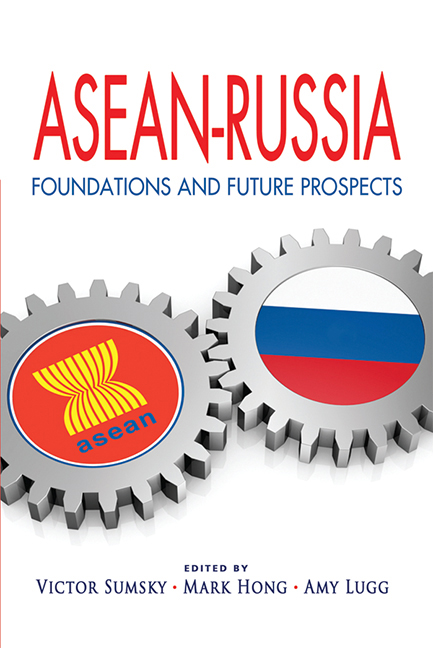Book contents
- Frontmatter
- Contents
- Foreword
- Preface
- About the Contributors
- Keynote Address
- Opening Remarks
- Keynote Address
- Introduction: Russia and the ASEAN Member States: Political and Economic Cooperation in Progress
- SECTION I WISEMEN'S VIEWS
- SECTION II GEOPOLITICS
- Russia in Southeast Asia: A New “Asian Moment”?
- ASEAN-Russia Military Ties: Reconfiguring Relations
- The Enlargement of the East Asia Summit: The Reasons and Implications of Bringing Russia In
- Russia's Entry into ASEM: Not Just a Courtesy Call?
- Russia-India-China: Acting in Concert in Southeast Asia?
- The South China Sea Issue: A View from Russia
- Southeast Asia and Russia: Forging a New Regional Architecture
- Russia-ASEAN Relations: An Indian Perspective
- SECTION III BILATERAL RELATIONS
- SECTION IV Business and Economics
- SECTION V CULTURE AND EDUCATION
- EPILOGUE
- Index
The Enlargement of the East Asia Summit: The Reasons and Implications of Bringing Russia In
from SECTION II - GEOPOLITICS
Published online by Cambridge University Press: 21 October 2015
- Frontmatter
- Contents
- Foreword
- Preface
- About the Contributors
- Keynote Address
- Opening Remarks
- Keynote Address
- Introduction: Russia and the ASEAN Member States: Political and Economic Cooperation in Progress
- SECTION I WISEMEN'S VIEWS
- SECTION II GEOPOLITICS
- Russia in Southeast Asia: A New “Asian Moment”?
- ASEAN-Russia Military Ties: Reconfiguring Relations
- The Enlargement of the East Asia Summit: The Reasons and Implications of Bringing Russia In
- Russia's Entry into ASEM: Not Just a Courtesy Call?
- Russia-India-China: Acting in Concert in Southeast Asia?
- The South China Sea Issue: A View from Russia
- Southeast Asia and Russia: Forging a New Regional Architecture
- Russia-ASEAN Relations: An Indian Perspective
- SECTION III BILATERAL RELATIONS
- SECTION IV Business and Economics
- SECTION V CULTURE AND EDUCATION
- EPILOGUE
- Index
Summary
INTRODUCTION
During the Association of Southeast Asian Nations’ (ASEAN) Summits in Hanoi in October 2010, the Russian Federation was officially invited to accede to the East Asia Summit (EAS). A similar invitation was extended then and there to the United States. Addressing the EAS leaders on that occasion, both the Russian Foreign Minister Sergei Lavrov and the U.S. Secretary of State Hillary Clinton pointed to the readiness of their nations to contribute to the strengthening of this forum as a vehicle for promotion of the regional strategic dialog and security cooperation.
The EAS is a fairly new phenomenon. Seven years ago, its first session in Kuala Lumpur brought together the heads of states and governments of the ten ASEAN members, along with their colleagues from China, Japan, South Korea, India, Australia and New Zealand — the combination of participants often referred to as ASEAN+6. As regards the U.S., way back in 2005, it did not claim a place at the discussion table. More than that, Washington actually made it known that it was not supportive of the idea to convene the EAS. By contrast, Russia not only indicated its interest in becoming a member, but fulfilled a major precondition of membership by signing the Treaty of Amity and Cooperation in Southeast Asia. This document, also known as the Bali Treaty of 1976, had always been, and remains in the eyes of ASEAN, the most important legal regulator of regional behaviour.
Nevertheless, Moscow's official application was politely declined. To explain this, it was said that Russia's relations with ASEAN nations (who enjoy the privilege of determining the EAS agenda and accepting new members) were not quite “substantive”. Basically, it implied that Russia-ASEAN trade was too small, compared to that between ASEAN and its key trading partners such as China, Japan and the United States. Since the launching of EAS was presented to the world as a measure to speed up regional economic integration and the birth of East Asian Community, saying “no” to Russia seemed justified — at least, to some extent.
- Type
- Chapter
- Information
- ASEAN-RussiaFoundations and Future Prospects, pp. 70 - 79Publisher: ISEAS–Yusof Ishak InstitutePrint publication year: 2012



